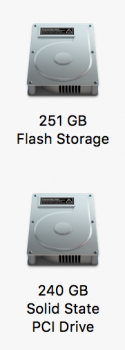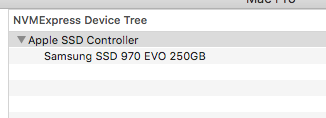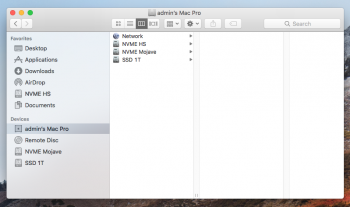It is well known that macOS sees PCI drives in a cMP as external. In the past, there have been several attempts to fix this annoyance, typically through codeless kexts and driver patches. However, these approaches are far from perfect.
Codeless kexts affect the properties of all (even non-PCI) drives. We therefore have to settle for calling all drives SATA or PCI. Patches can be dangerous, especially if applied to critical kexts. After system updates, these modifications can prevent the system from booting. There are also bootloader approaches, but these are better suited for hacks and not real Macs.
The problem is not just cosmetic. Improperly identified drives can cause issues for Boot Camp Assistant and the macOS installer.
I am currently working on an actual kext that addresses the problem. The kext simply changes the pertinent properties of PCI drives so that they can be seen as internal. So far, the approach works nicely with the 256 GB Apple SSUBX and the 240 GB Kingston HyperX Predator, the drives which I possess. This is how the drives now appear, for example, under Storage in About this Mac:

If there is interest in the community for the kext, I will make it available. However, to support other drives, particularly NVMe ones, I would need the names of PCI drives reported in System Information:

And, of course, some brave testers. Let me know if you're interested!
Current device list: Innie should now work with any SATA (AHCI) or NVMe drive.
Please refer to Post #9 for the kext and installation instructions.
Codeless kexts affect the properties of all (even non-PCI) drives. We therefore have to settle for calling all drives SATA or PCI. Patches can be dangerous, especially if applied to critical kexts. After system updates, these modifications can prevent the system from booting. There are also bootloader approaches, but these are better suited for hacks and not real Macs.
The problem is not just cosmetic. Improperly identified drives can cause issues for Boot Camp Assistant and the macOS installer.
I am currently working on an actual kext that addresses the problem. The kext simply changes the pertinent properties of PCI drives so that they can be seen as internal. So far, the approach works nicely with the 256 GB Apple SSUBX and the 240 GB Kingston HyperX Predator, the drives which I possess. This is how the drives now appear, for example, under Storage in About this Mac:

If there is interest in the community for the kext, I will make it available. However, to support other drives, particularly NVMe ones, I would need the names of PCI drives reported in System Information:

And, of course, some brave testers. Let me know if you're interested!
Current device list: Innie should now work with any SATA (AHCI) or NVMe drive.
Please refer to Post #9 for the kext and installation instructions.
Last edited:



